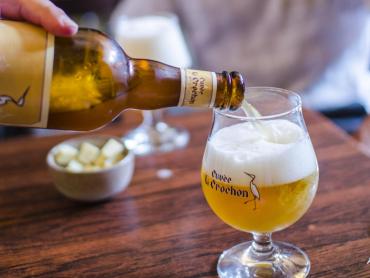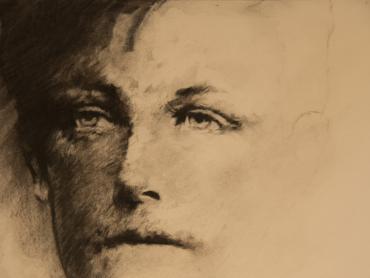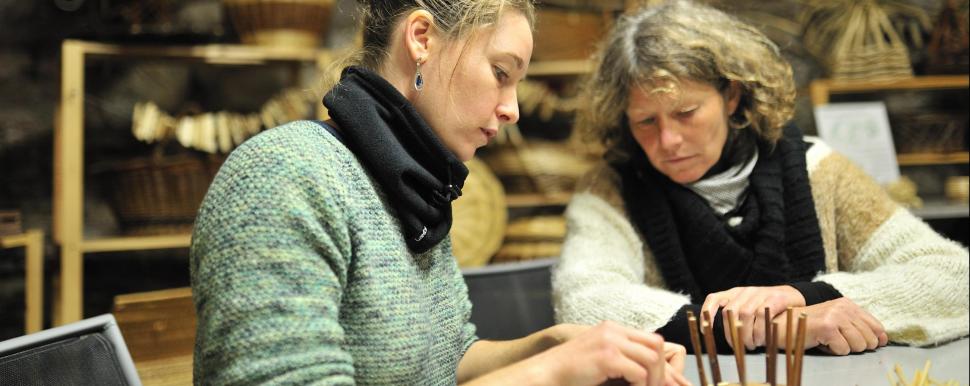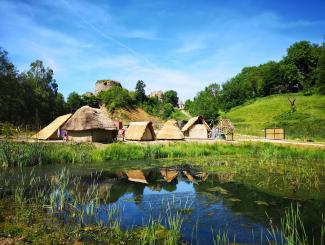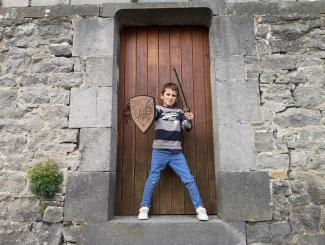I learned the ancient art of basketwork with O Fil de l'Osier
Natural craftwork, or how to make your own wicker basket
5 mins OF ESCAPE
A craftswoman in Haybes perpetuates an ancient savoir-faire using wicker and water. The golden hands of Sandra Meunier are breathing new life into the craft of wickerwork... and I couldn't wait to try it.
The River Meuse flows silently through the village of Haybes, generating that gentle serenity so typical of the Ardennes, far from the hustle and bustle of life in the city. There, I go to meet a bubbly little lady named Sandra Meunier, in her small workshop. For three years, she has been reviving the art of weaving wicker, or wickerwork. This craft goes back to the beginning of time and plays a role in our history. During the 1930s, France was full of wicker baskets... We went shopping with a basket on our arm. We had log baskets in our homes and used wicker trunks when we moved house. Country dwellers used baskets to gather the fruits of nature, while harvested grapes were carried in wicker hampers and apples or pototoes were stored in wicker crates... Wickerwork traditions were present in the rest of the department too. In the south, the countryside around Vouziers was dotted with wicker workshops and cooperatives which produced the famous Ardennes suitcase. But the period after the end of the war brought with it the plastic era and an entire branch of this craft economy disappeared.

Living a dream…
Sandra took over, leaving her job as an ecology consultant, hoping to make a living from her artistic merit. "I wanted to do something manual, so my career change meant learning a craft, but which one?" After considering a few ideas, she quickly chose wickerwork. "I discovered an extraordinary world," she says. Her workshop in Haybes, which I'm visiting, is a tiny structure housing a few tools, some willow branches, a water supply, and nothing else...
I'm impatient to get to work on these natural materials and handle them without the help of any noisy machines. Here, the art is in the twisting and weaving.
The craftswoman makes her product thanks to this raw material from the land and her own expertise, which she had to acquire. Sandra tells me she went back to school, in Marne, to learn these ancient weaving techniques.
If you're going to use the basket for fruit, it's important for the wicker to be as natural as possible…
Wickerwork trends
This craftwork is sustainable and ecofriendly by nature. The raw materials are produced naturally, in France. As she prepares her tools, Sandra explains, "I like the ethics of the material being as natural as possible. If you're going to use the basket for fruit, it's important for the wicker to be as natural as possible... I give priority to local production. Wicker from abroad, from eastern countries, breaks easily and I suspect it's been treated and boiled to remove the bark quickly. I select high-quality canes from wicker growers in Marne," the artisan reminds me. Wicker comes from a variety of willow that is cut in winter. Sandra shows me some bundles: she uses lengths of 1 metre, 1.2 metres and even 1.6 metres, and selects specific varieties for their flexibility or their robustness. For my imminent experience as a wickerworker, Sandra is already choosing for me a supple variety that's easier to use. She explains that they're kept in a cool, well-ventilated place. Wicker has to dry before it's used as it contains a lot of water, so the thicker canes have to be stored for six months to a year. Drying maintains the wicker's visual qualities, and it is soaked before handling. Natural wicker is immersed in water for between one and three weeks. White wicker, on the other hand, only needs to soak for an hour. "If I don't use it quickly, it goes mouldy. I have to plan ahead," she explains. The art of this craftswoman lies in her feel for the material and her ability to judge the ripeness of the plant: wicker evolves like a plank of wood, it's as simple as that.
Weaving with knowledge
Sandra is a mine of ideas when it comes to her art. "I enjoy working with materials from local artisans, it's what makes every item unique. I can choose the colour, the shape and even use a ceramic basket bottom designed by another artisan." She transforms wicker into everyday objects that are both practical and pleasing to the eye. In the workshop, I'm wide-eyed at the sight of a wickerwork rattle. She tells me it's an ancient custom to give them to mums-to-be. "The stones inside represent the 7 cardinal sins. As long as they stay inside the rattle, they protect the baby..."
Baskets evolve in her hands. She turns old-fashioned, kitschy items into modern ones. She takes one off its hook to show me. "White used to be used a lot, but I like to use a mixture of colours for a wider range of creations.". Her products appeal in these modern versions. Wickerwork is long-lasting and attractive and can be mended again and again, practically without limits. You might even say it's back in fashion...
After learning an ancient technique and making something out of a natural material, I'm pleased with the result
Art and matter
It's now time to try the experience of weaving wicker to make a little basket. This is what Sandra offers on her training courses. She has already made the bottom of my basket out of a piece of wood with some vertical supports. I take a stalk and fold it. It's amazing how flexible and easy to handle it becomes after soaking! Sandra explains the straightforward design of my basket. I weave away, in and out of the supports. With the material between my fingers I get a good idea of how robust it is. I'm guided by the stalk, weaving it round and round and watching the plant-based skeleton grow. "This is a typically French weaving technique," Sandra says, as I continue weaving, concentrating on "closing" my basket. "With this method the basket can be undone at any time, to mend the basket bottom, for example. Another technique, called the Spanish method, is faster as an item can be made out of just one stalk in a single movement, but the finished item can never be repaired."
When the desired basket depth is reached, I use secateurs to cut off the surplus wicker. After learning an ancient technique and making something out of a natural material, I'm pleased with the result. I am, however, a little amused by my basket which is very basic in comparison with those made by the craftswoman. Around the workshop I can see items that, unlike mine, require plenty of skill and harmonious gestures, as well as a dose of strength when it comes to weaving the handle... But Sandra loves the feel of wicker, that subtle sensation of the stalks whipping the air with a cracking sound worthy of a percussion instrument. Has wickerwork become a sensual experience?
Try this experience
Atelier de vannerie "O fil de l'Osier"
16 rue du Dr Bonnet
08170 HAYBES
06.70.74.55.83
The workshop can open daily
Reservations and information:
ofildelosier@laposte.net
https://ofildelosier.business.site/






